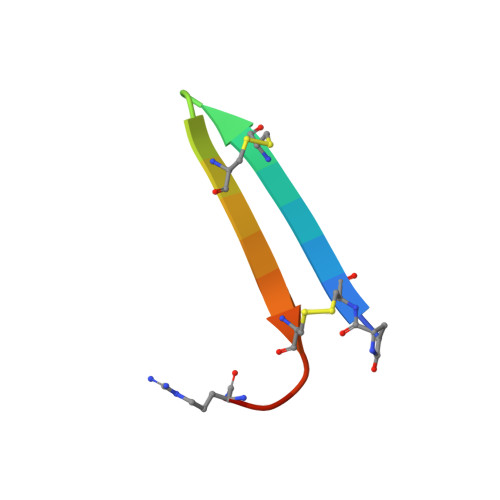The unusual conformation of cross-strand disulfide bonds is critical to the stability of beta-hairpin peptides.
Deplazes, E., Chin, Y.K., King, G.F., Mancera, R.L.(2020) Proteins 88: 485-502
- PubMed: 31589791
- DOI: https://doi.org/10.1002/prot.25828
- Primary Citation of Related Structures:
6MY1, 6MY2, 6MY3 - PubMed Abstract:
The cross-strand disulfides (CSDs) found in β-hairpin antimicrobial peptides (β-AMPs) show a unique disulfide geometry that is characterized by unusual torsion angles and a short Cα-Cα distance. While the sequence and disulfide bond connectivity of disulfide-rich peptides is well studied, much less is known about the disulfide geometry found in CSDs and their role in the stability of β-AMPs. To address this, we solved the nuclear magnetic resonance (NMR) structure of the β-AMP gomesin (Gm) at 278, 298, and 310 K, examined the disulfide bond geometry of over 800 disulfide-rich peptides, and carried out extensive molecular dynamics (MD) simulation of the peptides Gm and protegrin. The NMR data suggests Cα-Cα distances characteristic for CSDs are independent of temperature. Analysis of disulfide-rich peptides from the Protein Data Bank revealed that right-handed and left-handed rotamers are equally likely in CSDs. The previously reported preference for right-handed rotamers was likely biased by restricting the analysis to peptides and proteins solved using X-ray crystallography. Furthermore, data from MD simulations showed that the short Cα-Cα distance is critical for the stability of these peptides. The unique disulfide geometry of CSDs poses a challenge to biomolecular force fields and to retain the stability of β-hairpin fold over long simulation times, restraints on the torsion angles might be required.
Organizational Affiliation:
School of Pharmacy and Biomedical Sciences, Curtin Health Innovation Research Institute and Curtin Institute for Computation, Curtin University, Perth, Western Australia, Australia.















